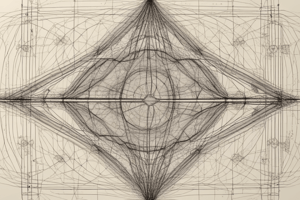Podcast
Questions and Answers
What are real numbers?
What are real numbers?
All numbers on the number line
Which of the following are natural numbers?
Which of the following are natural numbers?
- 0
- 5 (correct)
- -3
- 1 (correct)
What are whole numbers?
What are whole numbers?
All counting numbers plus 0
What are integers?
What are integers?
Define rational numbers.
Define rational numbers.
What are irrational numbers?
What are irrational numbers?
What is absolute value?
What is absolute value?
What are factors?
What are factors?
What is a product?
What is a product?
Define reciprocals.
Define reciprocals.
How do you multiply fractions?
How do you multiply fractions?
How do you divide fractions?
How do you divide fractions?
What happens when you add and subtract fractions?
What happens when you add and subtract fractions?
What is an algebraic expression?
What is an algebraic expression?
How do you evaluate expressions?
How do you evaluate expressions?
What does it mean to solve equations?
What does it mean to solve equations?
What are opposites or additive inverses?
What are opposites or additive inverses?
What is the commutative property of addition and multiplication?
What is the commutative property of addition and multiplication?
State the associative properties of addition and multiplication.
State the associative properties of addition and multiplication.
What is the distributive property of multiplication over addition?
What is the distributive property of multiplication over addition?
What is the additive inverse property?
What is the additive inverse property?
Explain the multiplicative inverse property.
Explain the multiplicative inverse property.
What is the additive identity property?
What is the additive identity property?
State the multiplicative identity property.
State the multiplicative identity property.
Define numerical coefficient.
Define numerical coefficient.
What is a term?
What is a term?
What is combining like terms?
What is combining like terms?
What is a linear equation in one variable?
What is a linear equation in one variable?
What are equivalent equations?
What are equivalent equations?
What is a formula?
What is a formula?
What does it mean to solve a formula?
What does it mean to solve a formula?
Flashcards are hidden until you start studying
Study Notes
Real Numbers
- Real numbers encompass all numbers present on the number line.
Natural Numbers
- Defined as counting numbers starting from 1: {1, 2, 3...}.
Whole Numbers
- Include all natural numbers plus 0: {0, 1, 2, 3...}.
Integers
- Comprise whole numbers and their negative counterparts: {..., -2, -1, 0, 1, 2...}.
Rational Numbers
- Can be expressed in the form of a fraction a/b, where a and b are integers and b ≠ 0.
Irrational Numbers
- Cannot be represented as fractions; include numbers like √2 or π.
Absolute Value
- Represents the distance of a number from zero on the number line, denoted as |x|.
Factors
- Refers to the components or parts of an expression that perform multiplication together.
Product
- The result obtained from multiplying two or more numbers.
Reciprocals or Multiplicative Inverses
- A number multiplied by its reciprocal yields 1 (e.g., a × (1/a) = 1).
Multiplying Fractions
- Achieved by multiplying the numerators together and the denominators together.
Dividing Fractions
- Accomplished by multiplying by the reciprocal of the divisor.
Adding and Subtracting Fractions
- Involves combining numerators when a common denominator exists, while the denominator remains unchanged.
Algebraic Expression
- A combination of numbers, variables, and operation symbols.
Evaluating Expressions
- Involves substituting a specific value for a variable and then simplifying.
Solving Equations
- Achieved by adding the opposite of a number to isolate the variable.
Opposites or Additive Inverse
- The sum of a number and its additive inverse equals zero.
Commutative Property of Addition and Multiplication
- Addition and multiplication can be done in any order: a + b = b + a and a × b = b × a.
Associative Properties of Addition and Multiplication
- The grouping of numbers does not affect the sum or product: (a + b) + c = a + (b + c) and (a × b) × c = a × (b × c).
Distributive Property of Multiplication Over Addition
- Involves distributing a multiplication over an addition: a × (b + c) = ab + ac.
Additive Inverse Property
- States that a number plus its additive inverse equals zero: a + (-a) = 0.
Multiplicative Inverse Property
- States that a number multiplied by its multiplicative inverse equals one: a × (1/a) = 1.
Additive Identity Property
- Indicates a number plus zero equals the number itself: a + 0 = a.
Multiplicative Identity Property
- Indicates a number multiplied by one equals the number itself: a × 1 = a.
Numerical Coefficient
- The numerical factor in a term, for example, in 10x + 5, the number 10 is the coefficient.
Term
- Represents a part of an expression, for instance, in the equation 5x = 25, 5x is a term.
Combining Like Terms
- Involves summing coefficients of similar variable terms, such as 5x + 10 = 2X + 40 and 3x + 10 = 40.
Linear Equation in One Variable
- An equation containing a single variable raised to the first power, e.g., 2x + 15 = 25.
Equivalent Equations
- Two equations are equivalent if they express the same relationship or yield the same solutions.
Formula
- An equation comprising multiple variables representing relationships among quantities, such as 2a + b = c.
Solving a Formula
- The process of manipulating variables to isolate a specific variable within the formula.
Studying That Suits You
Use AI to generate personalized quizzes and flashcards to suit your learning preferences.




